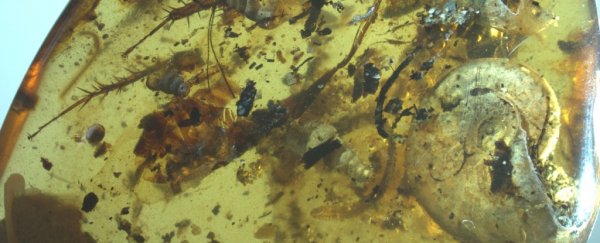Amber from Myanmar in Southeast Asia is turning out to be an incredibly rich resource for examining the natural world of 100 million years ago. In the last year, it's turned up frogs, snails, a snake, weird feathers, and some pretty wacky bugs. What do all of those have in common? They're land-dwellers.
But now palaeontologists have discovered something really weird in a small chunk of Cretaceous Myanmar amber: sea creatures, side-by-side with land-dwelling creatures.
That's four sea snails, and a juvenile marine ammonite from the ocean. Four intertidal isopods (and three more possible isopods), which dwell in the zone between high and low tide, were also trapped, along with beach sand.
 (Bo Wang)
(Bo Wang)
From the land, the amber contains 22 mites, what seems to be a goblin spider, 12 adult insects (eight flies, two beetles, a parasitic wasp and a cockroach) and a millipede. And it's all in a chunk just 33 millimetres by 9.5 millimetres by 29 millimetres.
It's a remarkable assemblage of creatures.
"It is rare to find aquatic organisms in amber, and it is extremely rare to find marine organisms in amber, let alone macroscopic marine organisms mixed with intertidal, terrestrial, and potentially freshwater aquatic organisms," the researchers wrote in their paper.
The piece is certainly mysterious. Palaeontologists have, for instance, been unable to figure out how old it is.
Uranium-lead dating of zircons in the matrix of volcanic rock in which the amber is found places it at around 98.8 million years old maximum, but a sandstone layer above the amber reportedly contained a fossilised ammonite that is thought to have arrived on the scene 113 million years ago, and not to have lived past 100.5 million years ago.
 (Yu et al., PNAS, 2019)
(Yu et al., PNAS, 2019)
The ammonite in question was neither described nor pictured in the paper that mentions it, and no one has been able to find the fossil itself to conduct a re-examination.
It's possible the amber itself is older than the bed it was collected from, so it could be more than 113 million years old. It's an issue that remains unresolved at this time.
Thankfully, exactly how such a diverse range of creatures ended up in the same piece of amber is a little easier to reconstruct.
Here lies the clue: the shells of the ammonite and the marine gastropods are lightly abraded, a significant piece of the ammonite shell was lost and the opening clogged with sand; there are also no signs of soft tissue belonging to either ammonite or gastropods.
And resin won't properly solidify when it's submerged in water - so it's unlikely a blob fell into the water and collected the marine animals there before turning into amber.
 Intertidal isopods. (Yu et al., PNAS, 2019)
Intertidal isopods. (Yu et al., PNAS, 2019)
So the palaeontologists have inferred that the marine creatures we see here had already died, their shells tumbled by the tides and washed up on a beach. It was there that they became caught up in a blob of tree resin.
"The exceptional occurrence of macroscopic marine macrofossils in the resin suggests that the amber forest was growing close to a coast, possibly next to a beach, and could have been subjected to exceptional events," the researchers wrote.
"The shells may record an exceptionally high, perhaps storm-generated tide, or even a tsunami or other high-energy event. Alternatively, and more likely, the resin fell to the beach from coastal trees, picking up terrestrial arthropods and beach shells and, exceptionally, surviving the high-energy beach environment to be preserved as amber."
And that's how they have remained for millions of years, buried beneath a sandstone bed in Myanmar. It's possible we may not be able to learn more about how such amber inclusions come about until others containing marine animals have been found.
But what an absolutely spectacular series of events.
The research has been published in PNAS.
